Goldtouch's marketing slogan, "Productivity Through Prevention," is
pretty close to home for me, capturing the dynamic I've been obliged to
practice for the past decade or so battling fibromyalgia and
polyneuritis, juggling the balance between productivity and disability
- at least insofar as typing and mousing on computers are
concerned.
Keyboards especially are a problem for me. The few I can tolerate
for more than a paragraph or two of typing are few and far between,
including the Kensington SlimType,
some of the Apple USB keyboards, a few ancient ADB 'boards like the
Macally Wave, and the built-in keyboards of the G3 Series and G4
PowerBooks and pre-"chiclet" MacBook Pros. The jury is still out on
the chiclet 'board in my Unibody MacBook, which I use
most of the time with an external keyboard.
Ergonomic Keyboards
There are ergonomic keyboards on the market as well with a variety
of approaches and innovations, such as the radical Kinesis Contour boards and the less-radical
but still somewhat unorthodox Key Ovation
Goldtouch keyboard, which claimed to be the first fully adjustable
ergonomic keyboard for Macintosh users.
I reviewed the standard Goldtouch Apple compatible keyboard some
time ago, finding it solidly built piece of work. Goldtouch's signature
approach is adjustable pronation, allowing you to configure its two
split alphanumeric keypad sections both horizontally and vertically to
suit your individual body requirements, thus easing stress on the
carpal tunnel and nerves and tendons in the wrist.
Placing your hands flat on the keys of a keyboard can require
considerable muscular effort, which in turn can cause fatigue and
discomfort. The Goldtouch keyboard's two keyboard segments can be
raised at the center to more closely match the natural alignment of the
forearm and wrist. Forcing your hands down to the keyboard is a hand
movement known as pronation. This is the rotation of the right hand in
a counterclockwise direction and clockwise for the left. The theory is
that assuming a more natural posture with the wrists at a relaxed angle
is conducive to relieving unnatural stress on muscles and tendons, thus
improving comfort and productivity while using your computer.
For example, if you orient the Goldtouch's keypads in an inverted-V
"vertical tenting" configuration with the nearsides splayed, your hands
and wrists can assume natural pronation body-English that does not
stress joints and tendons, or the carpal tunnel. Adjustment within the
0° to 30° range in both planes is infinite, quick, and easy to
change.
The major downside of the Goldtouch keyboard for road warriors is
that it's pretty bulky (notwithstanding having no numeric keypad) and
heavy for its size, presumably thanks to a rugged, durable
construction, but not something you would want to pack along in your
computer case or backpack.
Ergonomics for the Road Warrior
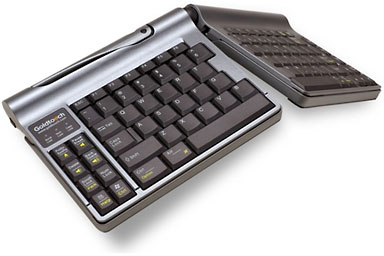 Goldtouch has now addressed that problem for road warriors with
the new Goldtouch
Go! Travel Keyboard, which retains the standard Goldtouch
keyboard's lockable center-articulation function, but incorporates it
in a much more compact and lighter package - indeed one of the smaller
and lighter freestanding keyboards of any sort that I've ever used
writing just 1 lb. 1 oz., and measuring 13.25" x 6" x 1" at its
thickest point.
Goldtouch has now addressed that problem for road warriors with
the new Goldtouch
Go! Travel Keyboard, which retains the standard Goldtouch
keyboard's lockable center-articulation function, but incorporates it
in a much more compact and lighter package - indeed one of the smaller
and lighter freestanding keyboards of any sort that I've ever used
writing just 1 lb. 1 oz., and measuring 13.25" x 6" x 1" at its
thickest point.
With full-sized keys approximately the size as those found on
14" notebooks, the Go! Travel Keyboard can accommodate large fingers
but offers similar key feel and travel distance as found on standard
Goldtouch 'boards.
The compact Go! Travel Keyboard is well-suited to use in limited
space environments and, with no numeric keypad, allows external mice to
be placed closer to the main keyboard, reducing shoulder pain and
increasing comfort.
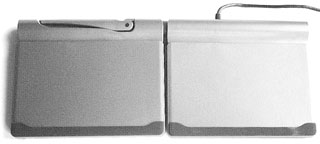 The first, somewhat disconcerting impression one has of the
Goldtouch Go! Travel Keyboard upon opening the shipping box is that it
appears to have no keys at all, because the keyboard halves are
equipped with slide-off covers to protect keyswitches from dirt and
impact damage when in transit in a backpack or computer bag. The covers
can also be used to sit the keyboard on when in use - a neat touch I've
never seen on any other laptop-oriented freestanding keyboard before,
although the screen lid serves that function on the laptop itself.
The first, somewhat disconcerting impression one has of the
Goldtouch Go! Travel Keyboard upon opening the shipping box is that it
appears to have no keys at all, because the keyboard halves are
equipped with slide-off covers to protect keyswitches from dirt and
impact damage when in transit in a backpack or computer bag. The covers
can also be used to sit the keyboard on when in use - a neat touch I've
never seen on any other laptop-oriented freestanding keyboard before,
although the screen lid serves that function on the laptop itself.
The covers slide off easily, once you figure out how they work,
but it might be a good idea for Goldtouch to add some sort of
indication of what to do - embossed arrows or silk-screened
instructions on the top perhaps. It took me several minutes to figure
it out.
The covers slide onto the undersides of the keyboard halves for
storage and also have a full-width rubber "foot" pad that, along with
smaller pads at the back of the unit, supply traction so the 'board
doesn't slide around on its support surface. These also allow you to
use the Goldtouch Go! situated on top of the laptop's own built-in
keyboard if desired without risk of scratching.
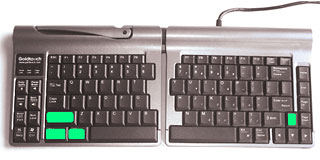 Once the keys are exposed, you're presented with a slightly
unusual, but reasonably familiar, key layout, happily with both Mac and
Windows labeling. A cool feature is that the board is instantly
convertible from Mac to PC or vice-versa by pressing a key command
combination. PC-to-Mac is left Control/Option-left Alt (white)-left
shift-Down Arrow key (on the right side)
Once the keys are exposed, you're presented with a slightly
unusual, but reasonably familiar, key layout, happily with both Mac and
Windows labeling. A cool feature is that the board is instantly
convertible from Mac to PC or vice-versa by pressing a key command
combination. PC-to-Mac is left Control/Option-left Alt (white)-left
shift-Down Arrow key (on the right side)
Mac-to-PC is left Control/Option-left Control (green control
key)-left Shift-Up Arrow (on the right side). One caveat is that
Goldtouch recommends switching the keyboard from Mac to PC mode before
unplugging it from a Mac, because if the keyboard is left in Mac mode
and you want to use it with a PC, the computer may not recognize it
immediately. The Goldtouch Go! Travel Keyboard requires Mac OS X
10.4 or higher.
The convertibility feature could be especially slick for folks who
run both the Mac OS and Windows in Boot Camp or Parallels on their
'Books.
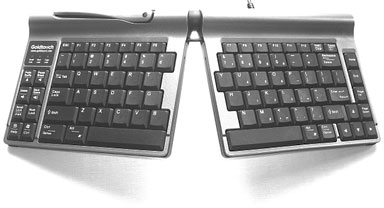
Not being a touch typist, I find the adjustment to nonstandard
keyboard layouts a bit of a challenge, as my conditioned relationship
with key location tends to be spatial/visual rather than by tactile
feel. On this 'board I find it consistently and annoyingly easy to hit
the Caps Lock key, which juts into the QWERTY area where one expects
the "A" to be located, but I expect touch typists will have less
difficulty.
The keys themselves have a low-effort action, with medium 3.2 mm
travel and a very light touch (39 g. to 42 g. resistance). Not quite as
good for me as the trusty SlimType, but one of the better 'boards I've
tried, with smooth key action that has no clicking shock or over-center
sensation to it, although the landing is a bit harder and more abrupt
than I prefer.
If you like "clicky" keyboards, this one is not for you.
There are no wrist rests, but the 'board is so slim that the support
surface it's sitting on should suffice when you're using it in flat
mode.
The articulation feature works similarly to the way it does on
the standard Goldtouch keyboard, with a large locking "over center"
lever on the left keypad to release and clamp the ball joint connecting
the two halves of the keyboard. It works easily and intuitively, and
when in locked position the 'board feels quite secure and solid. You
can adjust keyboard angle infinitely between flat and the limit of
elevation, and likewise for lateral splay - 0° to 30°
adjustment for ulnar deviation (wrist splay) in the horizontal plan,
combined with 0° to 30° adjustment for wrist pronation
(vertical tenting).
You can of course also use the Goldtouch Go! keyboard in
conventional flat orientation. You would probably not want to pay the
premium price for this sort of use exclusively, but it is very
convenient if more than one person uses the computer and other users
are not accustomed to and comfortable with typing on a split and angled
orientation 'board.
A particular point of appreciation I
want to emphasize is that despite its compact size, the Goldtouch Go!
Travel Keyboard has a USB repeater port - something seldom seen on
laptop-oriented keyboards - or for that matter even on some larger
sized ones these days (in fact, there were none on the full-sized
Goldtouch Apple Compatible 'board I tested). If they can find room in a
'board this tiny for a USB port, no one has any excuse for not
including one. The extra USB port looms especially large in importance
with Apple's port-impoverished MacBook lines, most critically of all
for the MacBook Air with
its pathetic single USB port.
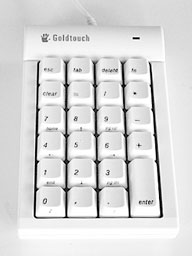 I'm less enamored of the lack of a numeric keypad, although I
appreciate the rationale in keeping the keyboard's footprint modest in
a unit designed for mobile use. There is a keypad function embedded in
the right-hand keypad and activated using the Num Lock key. Goldtouch
also offers an optional, freestanding numeric keypad module for
$49.95.
I'm less enamored of the lack of a numeric keypad, although I
appreciate the rationale in keeping the keyboard's footprint modest in
a unit designed for mobile use. There is a keypad function embedded in
the right-hand keypad and activated using the Num Lock key. Goldtouch
also offers an optional, freestanding numeric keypad module for
$49.95.
Bravo for including page navigation keys, although they have an
unorthodox layout vertically on the right periphery of the keyboard,
with the End key non-intuitively located just below the Home key
instead of at the bottom, where you would expect to find it. There's
also a Forward Delete key (hooray!), and a standard inverted tee set of
arrow keys, but I do miss having a dedicated Function key.
At the opposing extreme left there is an eight-key pad with
substantially different functions for Mac and Window for most of them
respectively. The combinations include (Windows/Mac):
- PntSc-SysRQ/Eject
- Pause Break/Audio Volume
- Delete/louder Volume
- Back Space/loudest Volume
- Scroll Lock/Power
- Num Lock/Num Lock
- Highlight Line/Help
- Windows Key/Control
The also ambidextrously labeled Apple Option and Command modifier
keys are in their usual positions when in Mac mode, and they morph into
Control and Alt respectively when in Windows mode on both sides of the
twin spacebars.
Above the left column keypad there are three indicator LEDs for
Scroll Lock, Num Lock, and Caps Lock.
Unlike the rich creamy shade of the standard Goldtouch Apple
compatible keyboard I tested (black is also available), the mobile
version is in a somber, dark shade of gray, which will be good for
camouflaging dirt but makes the key caps a bit murky for those of us
who depend partly on visual identification - a shortcoming shared with
the black chiclet keyboards on Apple's current laptops.
I prefer corded keyboards to wireless, and this one has a nice long
cord.
Like the full-sized Goldtouch, the Go! Travel 'board is on the
pricey side - indeed the mobile 'board is $10 more expensive at $139 -
but this is a highly engineered, quality constructed piece of
equipment, and if it eases your typing pain, you'll probably deem it an
investment in productivity through prevention and hence cheap at the
price.

 Goldtouch has now addressed that problem for road warriors with
the new
Goldtouch has now addressed that problem for road warriors with
the new  The first, somewhat disconcerting impression one has of the
Goldtouch Go! Travel Keyboard upon opening the shipping box is that it
appears to have no keys at all, because the keyboard halves are
equipped with slide-off covers to protect keyswitches from dirt and
impact damage when in transit in a backpack or computer bag. The covers
can also be used to sit the keyboard on when in use - a neat touch I've
never seen on any other laptop-oriented freestanding keyboard before,
although the screen lid serves that function on the laptop itself.
The first, somewhat disconcerting impression one has of the
Goldtouch Go! Travel Keyboard upon opening the shipping box is that it
appears to have no keys at all, because the keyboard halves are
equipped with slide-off covers to protect keyswitches from dirt and
impact damage when in transit in a backpack or computer bag. The covers
can also be used to sit the keyboard on when in use - a neat touch I've
never seen on any other laptop-oriented freestanding keyboard before,
although the screen lid serves that function on the laptop itself. Once the keys are exposed, you're presented with a slightly
unusual, but reasonably familiar, key layout, happily with both Mac and
Windows labeling. A cool feature is that the board is instantly
convertible from Mac to PC or vice-versa by pressing a key command
combination. PC-to-Mac is left Control/Option-left Alt (white)-left
shift-Down Arrow key (on the right side)
Once the keys are exposed, you're presented with a slightly
unusual, but reasonably familiar, key layout, happily with both Mac and
Windows labeling. A cool feature is that the board is instantly
convertible from Mac to PC or vice-versa by pressing a key command
combination. PC-to-Mac is left Control/Option-left Alt (white)-left
shift-Down Arrow key (on the right side)
 I'm less enamored of the lack of a numeric keypad, although I
appreciate the rationale in keeping the keyboard's footprint modest in
a unit designed for mobile use. There is a keypad function embedded in
the right-hand keypad and activated using the Num Lock key. Goldtouch
also offers an optional, freestanding numeric keypad module for
$49.95.
I'm less enamored of the lack of a numeric keypad, although I
appreciate the rationale in keeping the keyboard's footprint modest in
a unit designed for mobile use. There is a keypad function embedded in
the right-hand keypad and activated using the Num Lock key. Goldtouch
also offers an optional, freestanding numeric keypad module for
$49.95.
